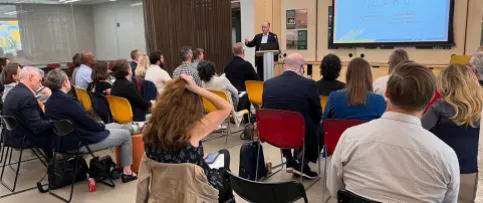Born and raised in New York City, I have been fortunate to have access to uniquely challenging opportunities that have advanced my academic and professional growth. I am an Asian American, a Pakistani-American Muslim woman, who found her way into the architecture industry in one of the most dynamic cities in the world. Today, I realize the rarity of this statistic. About 10% of female architects identify as Asian, and the proportion of Pakistani architects is too small to measure. In a world where the voices of diversity, equity, and inclusion (DEI) need to continue to make an impression, I’m looking retrospectively at my own journey—to share the barriers and boosters of my own path and increase the number of minorities in my industry.
My Early Experiences With Architecture
At a young age, my gateway into architecture was my father, who worked in the engineering/construction project management areas. I believe family influence created a sense of belonging through which I felt comfortable enough to take a leap of faith in this industry. Familiarity eliminates the fear of the unknown.
Growing up, I was nurtured, shaped by educators and mentors alike, learning those soft skills that would discipline me for academia and the years beyond. I never faced any barriers to pursuing my goal. Perhaps it was my naivety, but up until this stage, I hadn’t pondered about deterrents and divisions to becoming an architect. Instead, the resources available to me—pedagogy and programming—were instrumental to my perception of and propensity for architecture.
The beginning of my educational journey marked the first of a series of barriers I identified. My first design studio professor, who also identified as a South Asian woman, and who I thought I would find some common ground with, wasn’t exactly welcoming. She held a condescending attitude and a tendency to discourage. Though I felt uncomfortable, I was too intimidated to speak out. I simply did not feel I belonged in this field of study.
As I progressed, I found it somewhat difficult to make a personal connection with architecture. Many professors spoke in "archi-speak," a playful term coined to describe the obscure and overly inflated language often used by architects to describe their work. I couldn’t always relate to their perspective on the profession; having a tie to my roots or community may have made architecture more personable.
Overcoming Barriers to Access and Equity
Schools of architecture need to actively educate students on career opportunities from day one—so they can make informed decisions about where their interests and skills align, and understand the various specialties that a degree in architecture can lead to. Had I left college more informed of the steps toward licensure, I may have jump-started the process sooner. Equity through education is the key to leveling the playing field for all aspiring architects.
I do feel that attending architecture school and working in New York City has increased my access to diversity in the profession—but it is not enough. There is a general absence of minorities at industry events. In particular, South Asian architects here in the U.S. seem to be few and far between. I can count on one hand the number of licensed Pakistani women architects I have met.
My Observations and Advice
Within the first couple of years as a working professional, I made some key observations about overcoming some of these barriers in the profession.
To flourish in my work setting, I learned from a young age that my success is attributed to several practices, like actively seeking out mentors who will provide guidance in the right direction. I’m also observant and vocal in my office in order to draw upon the experience of others and contribute as part of a team. I’ve learned that licensure candidates need to be proactive when pursuing employment opportunities in order to grow and express what they need to meet experience requirements.
I find that there is too often a culture of routine, or being “stuck” with the same responsibilities day in and day out. Discussions with your supervisor to clarify how your role can be expanded to capture different scopes of work is key. While my progression in architecture has thrown some surprises my way and taken me into branches of work I did not imagine, I believe it is possible and important to create a roadmap that can at least loosely set out your envisioned path.
I also believe aspiring architects need to be more communicative with their employer. When I made my first transition out of an old position and into a new one, I was able to build my technical toolkit further and expand my skills. It started with asking the right questions during my interview process. When you’re interviewing, you should keep in mind the following questions: Will you have a licensed supervisor who can sign off on your work experience for licensure? Will you have the opportunity to engage in the diverse work settings outlined in NCARB’s Architectural Experience Program® (AXP®)?
Consequently, I found that my experience in documenting experience (under the previous Intern Development Program) was positive and productive. Just as my employers set expectations for me, I set expectations for them as far as what experiences I needed from my career. With such open communication, I always felt respected by my supervisors. And by expressing my goals, I was given opportunities to be challenged and grow as a professional.
While most candidates have positive experiences completing the AXP, women of color are far more likely to report difficulty finding a supportive firm, according to NCARB’s joint study with the National Organization of Minority Architects.
While I can only speak from my own personal experiences and recognize that others may face different barriers, I can offer some advice on how to navigate the profession and overcome these roadblocks:
- Increase Your Access: Seek out firms that will support you professionally. For me, firm support included supporting licensure—providing study materials, providing employment incentives (like a promotion), paying for licensing exams/fees, and providing continuing education opportunities.
- Commit to Preliminary Experience Planning: Ask your employer the tough questions, whether it’s for an interview or a performance evaluation. Find mentors at your firm who have already navigated similar waters! They may be able to see qualities in you that you do not see in yourself and predict where your future could lead. The proper upfront research will save you time and get you on track in architecture.
- Challenge Yourself: Diversify your work settings, whether it is for licensure or to grow your competence. When you get too comfortable, ask if you can shadow or take on a new project. Set standards for yourself, and do not undervalue your contributions and ability to expand your work role.
- Diversify Your Network: If diversity and inclusion are limitations in your city, strengthen ties to professional organizations in other cities. Make an effort to attend conferences where you can share your professional perspectives on a public platform or reach wider audiences through writing and speaking opportunities. Make friends with those you can achieve a sense of belonging with.
To learn more about Farah Ahmad, a New York-based sustainable architect, visit her website and connect with her on Instagram. Read NCARB and NOMA’s Baseline on Belonging study at www.ncarb.org/belong.
The opinions expressed in this commentary are solely those of the author and do not necessarily reflect those of the National Council of Architectural Registration Boards (NCARB).



